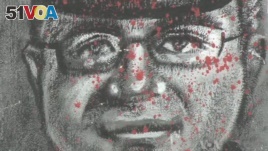February 10,2014
DEARBORN, MICH. — In many countries throughout the Middle East and North Africa, walls and buildings became the canvas for street art during the Arab Spring uprisings that began in 2011 and gave protestors a platform. A collection of protest artwork is just one part of the exhibit called “Creative Dissent” at the Arab American Museum in Dearborn, Michigan. The exhibit also explores how digital technology has changed the way some expressions of protest are created and disseminated.

When the Arab uprisings began, they took Islamic art professor Christiane Gruber by surprise. But as she watched events unfold, especially in Egypt, she began to focus on one aspect.
“I was fascinated as I was following it online, especially what was happening in Tahrir, by the extent to which the demonstrations were being articulated through all of this creative media, particularly through arts and through humor,” said Gruber.
Expressions of protest have fascinated Gruber for decades.
“The arts play a really critical role in expressions of politics, and oftentimes when humans communicate with one another, especially in large public settings, like the streets or squares. They don’t just use language. They use art forms, they use very poignant images, they use repeated slogans,” said Gruber.
Gruber said that many of the slogans chanted in the streets from Tunis to Tahrir Square and beyond are themselves artistic expression.
“When you chant them over and over again, it’s almost like you are mimicking a heartbeat, so I’ve seen this quite a bit in the streets of Istanbul as well. So I can personally attest to the emotive resonance some of these might have,” said Gruber.
That poetic rhythm weaves itself through the Creative Dissent exhibit Gruber curated at the Arab American Museum in Dearborn, Michigan. The slogans join photographs of key moments during the uprisings, and stand next to carefully crafted images that take aim at leaders accused of oppression.
Gruber said her biggest challenge was the lack of original material.
"Curators tend to work with art objects so there are more traditional methods of exhibiting materials. These are not art objects. Most of the materials, as I’m sure you noticed, are large scale reproductions of digital images,” explained Gruber.
Gruber points out that technology has changed the audience for many protest artists. Before the availability of digital technology and instant dissemination, some of this artwork might never have been seen beyond their original location.
“And I think without these other media, we wouldn’t have a show, because we’re bringing together a Facebook platform, puppet shows which are really in theaters, the chants which are in the streets, so we’re trying to give an idea of the really complex intersection of what’s happening out in the public, what’s happening online, what’s happening through livestream media, so it was a bit challenging to capture that chaos in a structured environment,” said Gruber.
That structured environment began as a symposium and grew into the exhibit now on display at the Arab American Museum. Gruber is working with the museum to take the exhibit on the road after it ends here in late February.